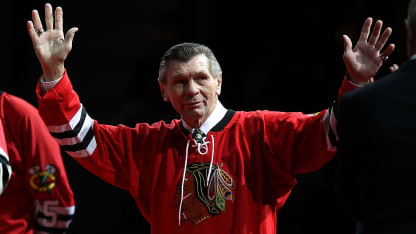Mikita, Blackhawks icon, dies at 78
Forward played entire 22-season NHL career with Chicago; four-time Art Ross Trophy winner

© Jonathan Daniel/Getty Images
Mikita played his entire 22-year NHL career with the Blackhawks. The forward is Chicago's all-time leader in points (1,467; 14th in NHL history), assists (926; 18th) and games played (1,396; 40th). He became the first Blackhawks player to have his number retired when his No. 21 was raised to the rafters at Chicago Stadium in 1980. Mikita is the only player in NHL history to win the Art Ross, Hart and Lady Byng trophies in the same season, and he did it back-to-back (1966-67, 1967-68).
"Stan Mikita lived a remarkable life and was a wonderful man, respected and revered by so many," NHL Commissioner Gary Bettman said. "One of the greatest players in NHL history and a Chicago icon, he was a pioneer of the game in so many ways. He designed the distinctive helmet he donned later in his career, when that still was a rarity. He curved his stick blade to an extent previously unthinkable, causing his shot to do tricks. He utterly transformed his playing style in his prime, going from one of the League's most penalized players to one of its most gentlemanly.
"Once he arrived in Chicago he never left, becoming a pillar of the city. He played in more games for the Blackhawks than anyone and came to be as much a symbol of the franchise as The Roar of Chicago Stadium and the United Center and the classic sweater. We are grateful for all Stan gave to us -- his fans, his game, his admirers, his league and his city -- and we mourn his passing."
Said Blackhawks president and CEO John McDonough, "Stan Mikita will be always remembered as a champion, an innovator and a master of the game. He embodied the Chicago Blackhawks. His excellence is illustrated by the team records he still holds today. His passion for the game was proved by the longevity of his playing career. The impact he had on the franchise is proved by fact that Blackhawks fans still wear his jersey to the United Center."
Blackhawks chairman Rocky Wirtz said, "There are no words to describe our sadness over Stan's passing. He meant so much to the Chicago Blackhawks, to the game of hockey, and to all of Chicago. He left an imprint that will forever be etched in the hearts of fans -- past, present and future. Stan made everyone he touched a better person."
At 5-foot-9, 169 pounds, Mikita was a dynamic offensive player who didn't have the flash of longtime teammate Bobby Hull. He overcame his lack of size with his tenacity and attention to detail.
"Sure, I can't tie Mikita's laces," teammate Lou Angotti said. "But neither can a hundred other guys in this league."
Mikita was born Stanislav Gvoth on May 20, 1940, in what was then Czechoslovakia. His life changed in 1948 when the country was taken over by a communist government; his parents allowed his aunt and uncle, Joe and Anne Mikita, to adopt their son and take him to St. Catharines, Ontario.
"When my aunt and uncle finally were taking me to the station in Prague, I wondered what Canada would be like," Mikita said in 1966. "But when I got to the station and saw that the train was ready to pull out and that my mother and father were going to be left behind, I wrapped my arms around a pole and cried. Every inch of the train ride I plotted to jump off and go back to my mother and father."
In Canada, he adopted his aunt and uncle's surname and began a new life that included sports. Not long after his arrival, Mikita saw a group of boys playing hockey in the street below his apartment building and quickly joined the game despite not speaking English and having almost no hockey experience. He later said among the first words he would learn in English were puck, stick, goal and foreigner.
Mikita's hockey career didn't begin in earnest until he was 13, when he was signed by Rudy Pilous, a farm system coach for the Blackhawks. Mikita spent three seasons playing for Chicago's Ontario Hockey Association team, the St. Catharines Teepees, but hadn't seriously contemplated a career in pro hockey until Hull, one of his teammates, was called up by Chicago.
Mikita, then 19, got his own call during the 1958-59 season.
"The Teepees' coach told me to put some clothes together because he was taking me to the train station to go to Chicago," Mikita said. "So I said, 'What am I going to Chicago for?' And he said, 'Well, they had an injury. They need you for the next game.' So I got there expecting a sleeper car. They said, 'You don't have a sleeper, not with this ticket.' I sat there on this old rickety wooden chair. I never slept a wink."
Mikita played three games with the Blackhawks in 1958-59, became a regular in 1959-60, and had 53 points (19 goals, 34 assists) the following season to help Chicago win the Stanley Cup for the first time since 1938. He joined the offensive elite of the NHL in 1961-62 when he finished with 77 points (25 goals, 52 assists), the first of 10 consecutive seasons he had 70 or more points. He won the Art Ross Trophy four times in a span of five seasons from 1963-64 to 1967-68 and had an NHL career-high 97 points (35 goals, 62 assists) in 1966-67.
Mikita won his first two scoring titles despite taking 146 and 154 penalty minutes. But he changed his style of play after 1965 and won the Lady Byng, given for skillful and gentlemanly play, for the 1966-67 and 1967-68 seasons.
"I was doing stupid things I shouldn't have been doing," he said of his makeover.
Off the ice, Mikita became involved in charitable efforts. In 1974, he founded the Stan Mikita Hockey School, a weeklong camp for children with impaired hearing that eventually helped spur the formation of the USA National Deaf Hockey Team.
Mikita was No. 3 on the NHL all-time scoring list when he retired after the 1979-80 season, and was inducted into the Hall of Fame in 1983. He worked in sales and as a golf pro, but gained a measure of renewed fame in 1992 when he appeared in the film "Wayne's World," which featured a Tim Hortons-parodying coffee shop in Aurora, Illinois, known as Mikita's.
"I put in 22 years as a pro athlete, and they remembered me from a doughnut shop in a movie," Mikita self-deprecatingly told Sports Illustrated.
Though the Blackhawks had retired his number, he had little contact with the team until 2007. Following the death of longtime owner William Wirtz, McDonagh reached out to Mikita and other stars of the past.
"I never thought I'd ever see the ice in the United Center," Mikita said. "But when John McDonough called me and asked me if I'd be interested in, if you will, becoming a Blackhawk again, I jumped at it."
Mikita and Hull were honored at a pregame ceremony March 7, 2008, when they were formally named team ambassadors. When the Blackhawks ended their 49-year Cup drought two seasons later by winning their first title since 1961, he and Hull were among those who received Stanley Cup rings. Mikita became a fixture at public events, even attending team functions while battling oral cancer in his early 70s.
On Oct. 22, 2011, the Blackhawks unveiled statues of Mikita and Hull outside United Center, where they stand beside one that honors Chicago Bulls legend Michael Jordan. It's a monument to perhaps the greatest player ever to spend his entire career in Chicago, and one who overcame numerous challenges to become one of hockey's all-time greats.
In 2015, Mikita was diagnosed with suspected Lewy body dementia, a brain disorder that can strip its victims of memory and cause hallucinations and sleep disorders. "His mind is completely gone," his wife, Jill Mikita, told the Chicago Tribune in 2015.
Mikita was named as one of the
100 Greatest NHL Players
in 2017.

















